We’ve all caught someone on our tv reading off of a cue card awkwardly placed beside a camera. The darting eyes of talent trying to keep up with prompts, is all too obvious. With upgraded technology, teleprompters let you ditch those cumbersome poster boards and opt for a sleeker solution that will have your talent breathe a sigh of relief. Mounted to a tripod just underneath of a camera, the iKan Teleprompter awards talent the opportunity to look directly into the camera while they deliver speeches, monologues, news reports and more at live events or for pre-recorded videos.
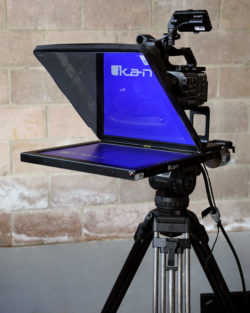
The iKan Teleprompter on display.
At its core, teleprompters have one purpose: feeding talent their lines. However, in the larger scope of things a teleprompter is adaptable to different formats, perfect for corporate work, talking head commercials, documentary interviews and even long tracking shots where your talent walks while talking.
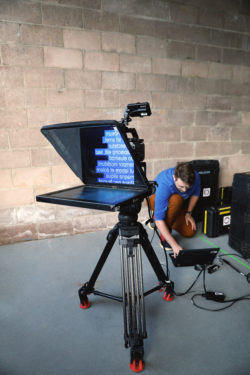
A camera tech edits the prompts on the iKan Teleprompter
The iKan Teleprompter can accommodate a large variety of cameras from large cinema cameras like the Arri Alexa 35 to smaller set-ups like the Sony a7s by utilizing different risers set to various camera levels.
Perhaps the best benefit to the iKan Teleprompter is its ability to edit and adjust in real time. A teleprompter operator can make changes directly in the software that streams the prompters from a nearby laptop. This means if your talent speaks quicker than expected or you need to pivot the prompts to alternative phrases you can adjust within minutes.
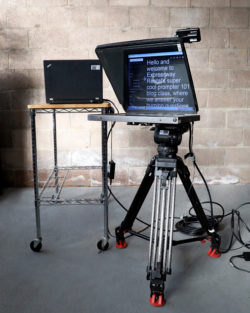
The iKan Teleprompter full set up.
Expressway includes all necessary power supplies and a laptop in our teleprompter kit. Please make sure to order a tripod separately as different tripods are compatible with different cameras.
Frequently Asked Questions:
Q: Will I need a tripod?
A: Yes! In order to properly mount your teleprompter, you will need a tripod that is compatible with your camera. When ordering a teleprompter kit with Expressway make sure to note which camera you are working with. From there we’ll find you a compatible tripod based on the weight of both the camera and the teleprompter. Generally, you’ll want a 20p tripod for medium set-ups (max payload of around 50 lbs), anything larger with bigger zooms or heavier camera systems you’ll want something more like the O’Conner 260.
Q: Do you need a trained teleprompter operator?
A: We always advise going the extra mile and hiring a teleprompter operator. In any production, you may only have a small window of time for that perfect shot. A trained teleprompter operator will work quickly and efficiently to make sure you don’t run behind schedule. Hiring an operator will give you someone who focuses on the speed at which the teleprompter scrolls, adjusting in real time based on how fast the actor or subject reads.
Q: How do I become a teleprompter operator?
A: Teleprompters have a fairly easy set-up and you can get trained in their usage within a couple of hours. Expressway is available to train and prepare operators to set up and monitor the iKan teleprompter system.
Q: Can I use a teleprompter for anything else?
A: Teleprompters came in handy during the early days of COVID-19. Directors had the opportunity to remain off set while conducting interviews or giving direction by way of video chats that could be cast on the teleprompter.
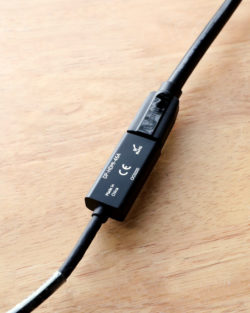
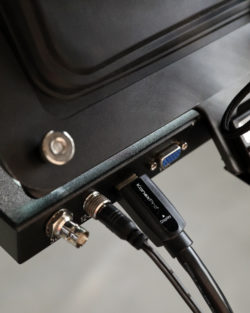
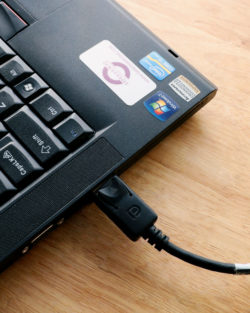
Common Troubleshooting:
Running into hurdles on set can be a costly setback for your schedule. The bad news: Teleprompters are not immune to troubleshooting. Good news: With teleprompters, It’s always a straight foward fix!
When running into issues, make sure to check out these tips to get back on track:
- Is the monitor displaying a blue screen with the iKan logo? That means it’s not receiving a signal. Here’s how to fix that!
- Make sure the cables are fully seated and, if using BNC, the twist lock is engaged.
- Ensure the attached computer is outputting externally.
- If using Windows, press ⊞ (Windows) + P, and select “Duplicate.”
- On a Mac, press Command ⌘ + F1.
- When possible, avoid using VGA. Not only is it more susceptible to bent pins, but it’s a relic of PCs of the 1980s, and the world has moved on to technically superior digital options.
- If you’re using one of Expressway’s kits, we’ve removed the VGA entirely to avoid confusion and to ensure reliability. A digital connection is either perfect or nonexistent – never poor-quality.
- Confirm the computer is outputting at an appropriate resolution. Typical resolutions include 800×600, 1024×768, 1280×960, and 1440×1080.
- Is the display backwards? No worries, a quick press of the “FLIP” button on the monitor should fix it.
- Are you getting stray light into your camera?
- Make sure the beamsplitter (the glass that reflects the display) is clean of any smudges or streaks. You can remove them by gently wiping it with a clean microfiber cloth.
- Ensure the lens donut (mmm, donuts) fully seals around the edges of the lens and the teleprompter.
- Avoid direct light and glare if possible.
And that’s that! Follow these tips and tricks and you’ll be saying, “iKan-t believe it’s not complicated.”